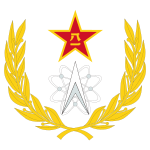People's Liberation Army Strategic Support Force
This article needs additional citations for verification. (January 2016) |
| People's Liberation Army Strategic Support Force | |
|---|---|
| 中国人民解放军战略支援部队 | |
 Emblem of the People's Liberation Army Strategic Support Force | |
| Founded | December 2015 |
| Country | |
| Allegiance | |
| Type | Cyber and space force |
| Role | Cyber warfare, space warfare, and electronic warfare |
| Part of | |
| Commanders | |
| Commander | General Gao Jin |
| Political Commissar | General Zheng Weiping |
| Insignia | |
| Badge |  |
The People's Liberation Army Strategic Support Force (PLASSF or SSF ; Chinese: 中国人民解放军战略支援部队) is the cyber-, space-, and electronic-warfare service branch of China's People's Liberation Army.[2][3][4] It was established in December 2015 as part of the first wave of the Chinese military reforms.[5][6][7]
History
Initial announcements did not provide much detail, but Yang Yujun of the Chinese Ministry of Defense described it as a combination of all support forces. Commentators speculate that it will include high-tech operations including space, cyberspace and electronic warfare operations, independent of other branches of the military.[5] Another expert, Yin Zhuo, said that "the major mission of the PLA Strategic Support Force is to give support to the combat operations so that the PLA can gain regional advantages in the space warfare and cyber warfare domains, and to ensure smooth operations."[8][9]
Structure
Functionally and structurally, the Strategic Support Force operates like the People's Liberation Army Rocket Force.[4] The SSF is formed from the units responsible for space, cyber, and electronic warfare in the former General Staff Department (including the cyber espionage capabilities of the former Third Department, the electronic support measures from the former Fourth Department, and the space-based ISR systems and Aerospace Reconnaissance Bureau and Satellite Main Station), General Political Department, and General Armaments Department (including the launch, telemetry, tracking, and control facilities and research and development organisations).[3] It is believed to have at least 5 departments, though debate has existed in Western commentary over the existence of a possible sixth department dedicated to equipment.
Space Systems Department
The PLASSF Space Systems Department is the consolidation of all PLA's space-based C4ISR systems. As of 2018 it's headed by Lieutenant General Shang Hong, with Lieutenant General Kang Chunyuan acting as political commissar.
- Jiuquan Satellite Launch Center / 20th Testing and Training Base
- Taiyuan Satellite Launch Center / 25th Testing and Training Base
- Xichang Satellite Launch Center / 27th Testing and Training Base
- Wenchang Aerospace Launch Site
- Space Telemetry, Tracking, and Control
- Beijing Aerospace Flight Control Center
- Xi’an Satellite Control Center / 26th Testing and Training Base
- Telemetry, Tracking, and Control Stations
- China Satellite Maritime Tracking and Control Department
- 23rd Testing and Training Base
- Aerospace Reconnaissance Bureau
- Satellite Main Station
- Aerospace Research and Development Center
- Project Design Research Center
- Astronaut Corps
Network Systems Department
The PLASSF Network Systems Department is the integration of all PLA information and cyberwarfare capabilities and is believed to have taken over many of the capabilities previously held by the Third and Fourth Departments of the PLA. As of 2018 it was headed by Lieutenant General Zheng Junjie, with Lieutenant General Chai Shaoling as political commissar, both of whom are also serving members of the 13th National People's Congress. Under its control, along with numerous military bases spread around China, is a department called the "Information Engineering University", which in turn has under its control numerous military academies around China.[10]
List of military bases under the NSD:[10]
- Notional Base 31, Nanjing
- Notional Base 32, Guangzhou
- Notional Base 33, Chengdu
- Notional Base 34, Shenyang
- Notional Base 36, Beijing
- Notional Base 38, Kaifeng
In addition, there are the military academies and other departments under the control of the IEU, found below;[10]
- S&T Research Department (科研部)
- Training Department (训练部)
- Command Information Systems Academy (指挥信息系统学院)
- Electronic Technology Academy (电子技术学院)
- Encryption Engineering Academy (密码工程学院)
- Luoyang Foreign Language Academy (洛阳外国语学院)
- Geospatial Information Academy (地理空间信息学院)
- Cyberspace Security Academy (网络空间安全学院)
- Navigation and Aerospace Target Engineering Academy (导航与空天目标工程学院)
- Command Officer Basic Education Academy (指挥军官基础教育学院)
- Blockchain Academy (区块链研究院; located in Shenzhen).
See also
- United States Cyber Command
- United States Space Force
- Russian Space Forces
- Defence Space Agency
- Defence Cyber Agency
References
- ^ "The PLA Oath" (PDF).
I am a member of the People's Liberation Army. I promise that I will follow the leadership of the Communist Party of China...
- ^ PLA Aerospace Power: A Primer on Trends in China’s Military Air, Space, and Missile Forces Air University
- ^ a b PLA Strategic Support Force: The 'Information Umbrella' for China's Military The Diplomat 1 April 2017
- ^ a b The Strategic Support Force: Update and Overview Jamestown Foundation China Brief Volume: 16 Issue: 19
- ^ a b "China Takes Bold Steps Toward Military Reform" (11 January 2016)
- ^ Costello, John; McReynolds, Joe (2018). China's Strategic Support Force: A Force for a New Era. Washington, DC: National Defense University Press. Retrieved 19 April 2019.
- ^ Mattis, Peter (March 3, 2017). "China Reorients Strategic Military Intelligence" (PDF). Jane's Intelligence Review. Retrieved January 18, 2020.
- ^ Expert: PLA Strategic Support Force a key force to win wars
- ^ Hacking Diplomatic Cables Is Expected. Exposing Them Is Not
- ^ a b c Burton, Rachel (25 September 2018). "The People's Liberation Army Strategic Support Force: Leadership and Structure" (PDF). Project 2049 Institute.
